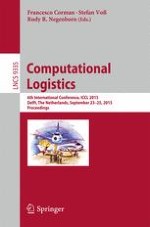2015 | Buch
Computational Logistics
6th International Conference, ICCL 2015, Delft, The Netherlands, September 23-25, 2015, Proceedings
herausgegeben von: Francesco Corman, Prof. Dr. Stefan Voß, Rudy R. Negenborn
Verlag: Springer International Publishing
Buchreihe : Lecture Notes in Computer Science
